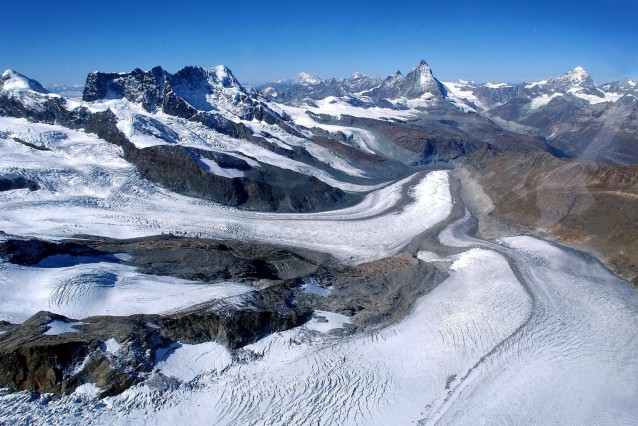Alps Warming At Double The Average Global Rate, New Study Confirms

About 20 years ago, melting ice high up in the Italian Alps exposed the 5,000-year-old body of Ötzi the Iceman, a stunning discovery that gave unprecedented insight into human life during that bygone era — not least exciting of which being an epic battle for survival during his final days. Now just miles away scientists have found evidence giving further insight into our current era, the Anthropocene, in which mankind is changing the global climate and ecology of the planet. A 2,600-year-old leaf found from a larch tree near the site of Ötzi’s discovery reconfirms that glaciers on the Italian Alps, which had remained frozen year-round for thousands of years, are now melting.
“Our first results indicate that the current atmospheric warming at high elevation in the Alps is outside the normal cold range held for millennia,” Paolo Gabrielli, a scientist at Ohio State University and leader of a six-nation team of glaciologists who made the find, said. “This is consistent with the rapid, ongoing shrinking of glaciers at high elevation in this area.”
The scientists presented their findings in San Francisco last week at the annual meeting of the American Geophysical Union. Gabrielli said that the Alto dell’Ortles glacier that they drilled ice cores into had not shown signs of melting for thousands of years until about 30 years ago.
The research team is especially interested in better understanding why the Alps are warming at about twice the average global rate. They want to determine if the highly populated surroundings might be contributing to the melting by causing soot to gather and darken the surface of the glaciers, which would attract more heat.
The research, which took place in 2011, found that the first 100 feet of the glacier is made up of thin layers of partially melted snow, built up over hundreds of years, which then turns to solid ice. The researchers found the leaf about 240 feet beneath the surface, encased in solid ice, further confirming that the glacier had remained unchanged for thousands of years.
Glaciers are not stationary objects, but slow-moving masses, making them hard to study without the direct observation which only goes back a few hundred years. However as glaciologists continue to study them, and discover ancient relics and climactic patterns, more valuable information about climate change and human evolution in general is likely to emerge.
One climatic trend that is directly visible — and visibly disappointing — to many is the shrinking skiing season in the Alps.
“The indicators that the Alps are warming up is clear. These findings are worrying, very worrying — maybe not for right now but for the second half of the century,” meteorologist Gilles Brunot told Ski The World earlier this year.
Brunot said that at lower lying elevations under 1,000 meters there’s been around 40 percent less snow over the last 50 years.
“What the evidence shows is that since the 1990s there has been a rapid rise in temperatures in the mountains and since the 1960s there has been a slower, but evident, trend of less snow at lower altitudes,” he said.
Victor Saunders, a British mountain guide living in the region, told Ski The World that the alpine landscapes were changing drastically.
“I have climbed glaciers in every continent including Antarctica and can say the glaciers have been shrinking rapidly over the last 10 years on every single one,” he said. “If the temperatures go up by 1 degree Celsius, then the glaciers recede uphill by almost 100 meters so it is really very visible. People who live and work in the mountains are very aware of climate change.”
You can return to the main Market News page, or press the Back button on your browser.

